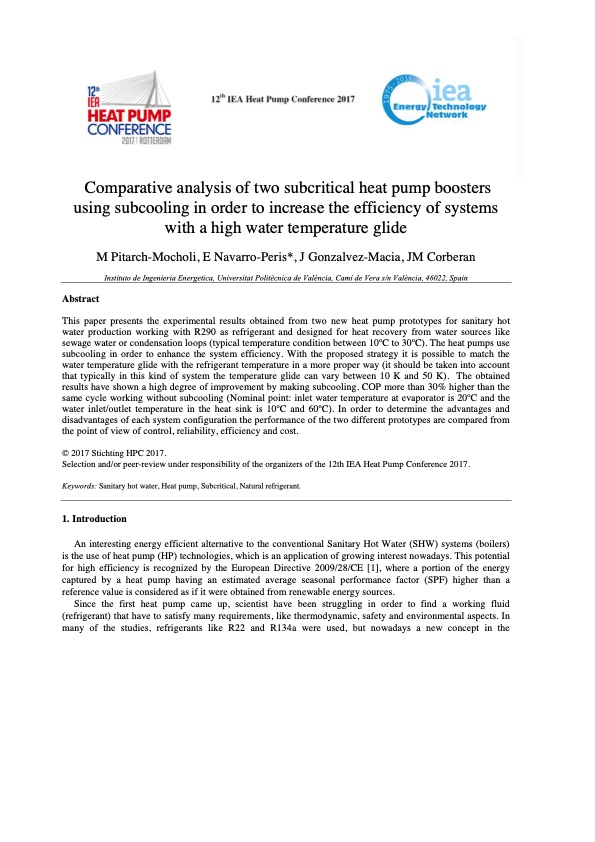
PDF Publication Title:
Text from PDF Page: 001
Comparative analysis of two subcritical heat pump boosters using subcooling in order to increase the efficiency of systems with a high water temperature glide M Pitarch-Mocholi, E Navarro-Peris*, J Gonzalvez-Macia, JM Corberan Instituto de Ingenieria Energetica, Universitat Politècnica de València, Camí de Vera s/n València, 46022, Spain Abstract This paper presents the experimental results obtained from two new heat pump prototypes for sanitary hot water production working with R290 as refrigerant and designed for heat recovery from water sources like sewage water or condensation loops (typical temperature condition between 10oC to 30oC). The heat pumps use subcooling in order to enhance the system efficiency. With the proposed strategy it is possible to match the water temperature glide with the refrigerant temperature in a more proper way (it should be taken into account that typically in this kind of system the temperature glide can vary between 10 K and 50 K). The obtained results have shown a high degree of improvement by making subcooling. COP more than 30% higher than the same cycle working without subcooling (Nominal point: inlet water temperature at evaporator is 20oC and the water inlet/outlet temperature in the heat sink is 10oC and 60oC). In order to determine the advantages and disadvantages of each system configuration the performance of the two different prototypes are compared from the point of view of control, reliability, efficiency and cost. © 2017 Stichting HPC 2017. Selection and/or peer-review under responsibility of the organizers of the 12th IEA Heat Pump Conference 2017. Keywords: Sanitary hot water, Heat pump, Subcritical, Natural refrigerant. 1. Introduction An interesting energy efficient alternative to the conventional Sanitary Hot Water (SHW) systems (boilers) is the use of heat pump (HP) technologies, which is an application of growing interest nowadays. This potential for high efficiency is recognized by the European Directive 2009/28/CE [1], where a portion of the energy captured by a heat pump having an estimated average seasonal performance factor (SPF) higher than a reference value is considered as if it were obtained from renewable energy sources. Since the first heat pump came up, scientist have been struggling in order to find a working fluid (refrigerant) that have to satisfy many requirements, like thermodynamic, safety and environmental aspects. In many of the studies, refrigerants like R22 and R134a were used, but nowadays a new concept in thePDF Image | Comparative analysis of two subcritical heat pump boosters using subcooling

PDF Search Title:
Comparative analysis of two subcritical heat pump boosters using subcoolingOriginal File Name Searched:
subcritical-heat-pump-boosters.pdfDIY PDF Search: Google It | Yahoo | Bing
CO2 Organic Rankine Cycle Experimenter Platform The supercritical CO2 phase change system is both a heat pump and organic rankine cycle which can be used for those purposes and as a supercritical extractor for advanced subcritical and supercritical extraction technology. Uses include producing nanoparticles, precious metal CO2 extraction, lithium battery recycling, and other applications... More Info
Heat Pumps CO2 ORC Heat Pump System Platform More Info
| CONTACT TEL: 608-238-6001 Email: greg@infinityturbine.com | RSS | AMP |